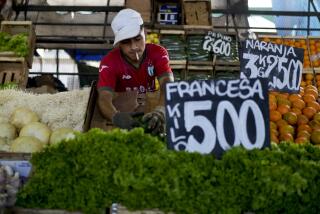Shrinking Trade Surplus, Rising Inflation Blamed : Drop in Value of Peso Called ‘Long Overdue’
- Share via
SAN DIEGO — Buffeted by a shrinking trade surplus, the declining spot-market price of heavy crude oil and government projections that inflation in Mexico this year could reach 58%, the recent dramatic drop in the value of the peso is “long overdue” and likely will continue, foreign currency experts said Friday.
“This is not a crisis; it’s long overdue,” said an economist with a major U.S. bank who asked that he not be identified.
The timing of the peso’s sharp devaluation on the free market--its value has dropped by about 60 pesos, or just under 25%, in the past six weeks--may not be accidental, given the municipal, congressional and gubernatorial elections being held in Mexico on July 7.
Stepped-Up Devaluation
And with Mexican banks set to be freed from federally controlled peso exchange rates beginning Monday, some analysts believe that government authorities are all-but-officially conceding a stepped-up devaluation.
“Something always seems to happen (with the peso) . . . close to an election,” said Rick Sinclair, foreign currency manager of Security Pacific National Bank in Los Angeles.
Indeed, Mexican officials likely would have announced some kind of official devaluation and various cuts in government spending after next week’s elections, according to foreign currency analysts.
But recent declines in the spot-market price of heavy crude oil from $25.50 per barrel to $24 “forced their hand,” according to one economist.
That added to Mexico’s already mounting economic woes. Its trade surplus in the first quarter was nearly $2.3 billion, off 42% from the year before.
And two weeks ago, government officials projected that the inflation rate in 1985 would probably run about 58%, higher than earlier projections of about 35%.
Since March, the government-controlled peso exchange rate has been increasing by 21 centavos per day--under Mexico’s ongoing phased peso devaluation--and would have been enough to meet earlier inflation projections.
But when inflation estimates were revised earlier this month, “you knew they had to do something,” one analyst said.
Meanwhile, beginning Monday, Mexican banks will be freed from government-controlled peso rates and will be allowed to trade alongside the “black market” exchange houses.
Under the controlled rate, banks buy one U.S. dollar for 240 pesos but sell 245 pesos for one U.S. dollar--called 240/245 in foreign currency parlance.
Depends on ‘Time of Day’
The black-market rate on Friday was 305/315 in San Ysidro, down a bit from Thursday’s 315/324.
The rate topped 300 to the dollar this week. In Laredo, Tex., International Bank of Commerce was buying pesos Thursday at 320 to the dollar, while Texas Commerce Bank in McAllen, Tex., had an exchange rate of 317 to one.
Merchants in Nogales, Ariz., were exchanging pesos at a rate of 298 to 308 to the dollar Wednesday.
The price, however, “depends on what time of day you call,” according to Mike Haskell, owner of Valuta Corp, which operates exchanges houses in San Ysidro, Los Angeles and El Paso.
“We determine (the price) solely on supply and demand,” Haskell said.
“This is a free market. If our volume and spread exceed our costs of doing business, we make money. We don’t care what the peso is worth--we’re interested in volume and spread.”
And the volume is overwhelming. “We’re getting calls from people who want to exchange 2 (million) or 3 million pesos at a shot,” Security Pacific’s Sinclair said.
But the other side of the coin is that Mexican banks “are having a hard time finding people to sell their dollars (and) buy pesos,” according to John Scott, manager of the bank note department at American Foreign Exchange in Los Angeles.
In a related development, Mexico President Miguel de la Madrid, during a visit to Baja California on Friday, announced a $509-million program to boost the economy of Mexico’s 1,900-mile border region.
The program will seek to increase Mexico’s imports to the United States by offering financial assistance to stimulate tourism, fishing, agriculture and mining along the northern border.
More to Read
Sign up for Essential California
The most important California stories and recommendations in your inbox every morning.
You may occasionally receive promotional content from the Los Angeles Times.













